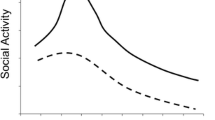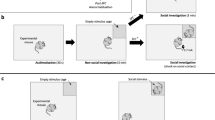Abstract
Although there are a variety of animal models used in alcoholism research, there has been very little experimental investigation into possible environmental/experiential factors leading to an initial bout of alcohol ingestion. Adolescent alcohol abuse is a major problem in today's society and research is beginning to focus on the predisposing conditions toward alcohol consumption, particularly in this vulnerable age group. The results of recent research from our laboratory are reviewed in which voluntary ingestion of ethanol by preweanling and adolescent rats is increased following exposure to an intoxicated sibling. This paradigm centers on the notion that rodents, and perhaps other mammalian species as well, acquire information about foods to ingest based in part on interaction with a conspecific that has recently ingested a novel diet (e.g. Galef, 1981). Smelling food-derived cues on the breath of another animal is known to affect later food choice. The procedures described in this paper represent a potential new model for examining the effects of early exposure to ethanol through social interactions on the initiation of voluntary alcohol ingestion.
Similar content being viewed by others
References
Anthony, J.C. & Petronis, K.R. (1995). Early-onset drug use and risk of later drug problemsDrug and Alcohol Dependence, 40, 9–15.
Bannoura, M.D., Kraebel, K.S., Spear, L.P., & Spear, N.E. (1998). Effects of preweanling ethanol odor exposure on ethanol preference.Alcohol, 15, 213–217.
Birch, L.L. (1980). Effects of peer model's food choices and eating behavior on preschooler's food preferences.Child Development, 51, 489–496.
Birch, L.L., Zimmerman, S.I., & Hind, H. (1980). The influence of social-affective context on the formation of children's food preferences.Child Development, 51, 856–861.
Bronstein, P.M., & Crockett, D.P. (1976). Exposure to the odor of food determines the eating preferences of rat pups.Behavioral Biology, 18, 387–392.
Capretta, P.J., Petersik, T.J., & Stewart, D.J. (1975). Acceptance of novel flavours is increased after early experience of diverse tastesNature, 254, 689–691.
Carroll, C.A. (2000).Socially mediated alcohol preference in preweanling rats. Unpublished Undergraduate Honors Thesis, College of William & Mary, Williamsburg, VA.
Clary, M. & Hunt, P.S. (1999),Short-term retention of socially-acquired increases in ethanol ingestion. Unpublished data.
Chou, S.P., & Pickering, R.P. (1992). Early onset of drinking as a risk factor for lifetime alcohol-related problems.British Journal of Addiction, 87, 1199–1204.
Cunningham, C.L., Fidler, T.L., & Hill K.G. (2000). Animal models of alcohol's motivational effects.Alcohol Research and Health, 24, 85–92.
Denenberg, V.H. (1964). Critical periods, stimulus input, and emotional reactivity.Psychological Review, 71, 335–351.
Dudek, B.C., Tritto, T., Case, K.A., Caldarone, B.J., & Clarke, J. (1999). Genetics, psychomotor stimulant effects of ethanol, and ethanol absorption in mice. In J.H. Hannigan, L.P. Spear, N.E. Spear & C.R. Goodlett (Eds.)Alcohol and alcoholism: Effects on brain and development (pp. 115–133). Mahwah, NJ: Erlbaum.
Fossey, F. (1993). Identification of alcohol by smell in young children: An objective measure of early learning in the home.Drug and Alcohol Dependence, 34, 29–35.
Galef, B.G., Jr. (1981). Development of flavor preferences in man and animals: The role of social and nonsocial factors. In R.N. Aslin, J.R. Alberts, & M.R. Petersen (Eds.),Development of perception: Psychobiological perspectives (Vol, 1. pp. 411–431). NY: Academic.
Galef, B.G. Jr. (1989) Enduring social enhancement of rats' preferences for the palatable and the piquant.Appetite, 13, 81–92.
Galef, B.G., Jr. & Henderson, P.W. (1972). Mother's milk: A determinant of the feeding preferences of weaning rat pups.Journal of Comparative and Physiological Psychology, 78, 213–219.
Galef, B.G., Jr. & Kaner, H.C. (1980). Establishment and maintenance of preference for natural and artificial olfactory stimuli in juvenile rats.Journal of Comparative and Physiological Psychology, 94, 588–595.
Galef, B.G., Jr. & Stein, M. (1985). Demonstrator influence on observer diet preference: Effects of simple exposure and the presence of a demonstrator.Animal Learning and Behavior, 13, 25–30.
Galef B.G., Jr. & Wigmore, S.W. (1983). Transfer of information concerning distant foods: A laboratory test of the “information-centre” hypothesis.Animal Behavior, 31, 748–758.
Gauvin, D.V., & Holloway, F.A. (1992). Ethanol tolerance developed during intoxicated operant performance in rats prevents subsequent ethanol-induced conditioned taste, aversion.Alcohol.,9, 167–170.
Grahame, N.J. (2000). Selected lines and inbred strains.Alcohol Research and Health, 24, 159–163.
Greenough, W.T., Madden, T.C., & Fleischmann, T.B. (1972). Effects of isolation, daily handling, and enriched rearing on maze learning.Psychonomic Science, 27, 279–280.
Hall, W.G. & Rosenblatt, J.S. (1977). Suckling behavior and intake control in the developing rat pup.Journal of Comparative and Physiological Psychology, 91, 1232–1247.
Hallmark, R.A., & Hunt, P.S. (2001).Opioid mediation of the expression of alcohol gustatory preferences. Manuscript submitted for publication.
Hennessy, M.B., Smotherman, W.P., & Levine, S. (1977). Early olfactory enrichment enhances later consumption of novel substances.Physiology and Behavior, 19, 481–483.
Heyser, C.J., Schulteis, G., & Koob, G.F. (1997). Increased ethanol self-administration after a period of imposed ethanol deprivation in rats trained in a limited access paradigm.Alcoholism: Clinical and Experimental Research, 21, 784–791.
Hollstedt, C., & Rydberg, U. (1985). Postnatal effects of alcohol on the developing rat. In U. Rydberg (Ed.),Alcohol and the developing rat (pp. 69–82). NY: Raven.
Hunt, P.S., Holloway, J.L., & Scordalakes, E.M. (2001). Social interaction with an intoxicated sibling can result in increased intake of ethanol in periadolescent rats.Developmental Psychobiology, 38, 101–109.
Hunt, P.S., Kraebel, K.S., Rabine, H., Spear, L.P., & Spear, N.E. (1993). Ehanced ethanol intake in preweanling rats following exposure to ethanol, in a nursing context.Developmental Psychobiology, 26, 133–153.
Hunt, P.S., Lant, G.M., & Carroll, C.A. (2000). Enhanced intake of ethanol in preweanling rats following interactions with intoxicated siblings.Developmental Psychobiology, 37, 90–99.
Kelly, S., Bonthius, D., & West, J.R. (1987). Developmental changes in alcohol pharmacokinetics in rats.Alcoholism: Clinical and Experimental Research, 11, 281–286.
Krech, D., Rosenzweig, M., & Bennett, E. (1962). Relations between brain chemistry and problem solving in rats raised in enriched and impoverished environments.Journal of Comparative and Physiological Psychology, 55, 801–807.
Leon, M., Galef, B.G., Jr., & Behse, J. (1977). Establishment of pheromonal bonds and diet choice in young rats by odor pre-exposure.Physiology and Behavior, 18, 387–391.
Li, T.-K., Lumeng, L., McBride, W.J., & Murphy, J.M. (1987). Rodent lines selected for factors affecting alcohol consumption.Alcohol and Alcoholism (Suppl. 1), 91–96.
McKinzie, D.L., Nowack, K.L., Murphy, J.M., Li, T.-K., Lumeng., L., & McBride, W.J. (1998). Development of alcohol drinking behavior in rat lines selectively bred for divergent alcohol preference.Alcoholism: Clinical and Experimental Research, 22, 1584–1590.
Mennella, J.A. & Beauchmap G.K. (1991). The transfer of alcohol to human milk: Effects on flavor and the infant's behavior.New England Journal of Medicine, 325, 981–985.
Mennella, J.A. & Beauchamp, G.K. (1993). Beer, breast feeding, and folklore.Developmental Psychobiology, 26, 459–466.
Mennella, J.A., & Garcia, P.L. (2000). Children's hedonic response to the smell of alcohol: Effects of parental drinking habits.Alcoholism: Clinical and Experimental Research, 24, 1167–1171.
Molina, J.C. & Chotro, M.G. (1989). Acute alcohol intoxication paired with aversive reinforcement: Ethanol odor, as a conditioned reinforcer in rat pups.Behavioral and Neural Biology, 52, 1–19.
Noll, R.B., Zucker, R.A., & Greenberg, G.S. (1990) Identification of alcohol by smell among preschoolers: Evidence for early socialization about drugs occurring in the home.Child Development, 61 1520–1527.
Panksepp, J., & Beatty, W.W. (1980). Social deprivation and play in rats.Behavioral and Neural Biology, 30, 197–206.
Pohorecky, L.A. & Brick, J. (1982). A new method for the determination of blood ethanol levels in rodents.Pharmacology, Biochemistry, and Behavior, 16, 693–696.
Randall, C.L. & Lester, D. (1975). Cross-fostering of DBA and C57bl mice: Increase, in voluntary consumption of alcohol by DBA weanlings.Journal of Studies on Alcohol, 36, 973–980.
Rozin, P. & Zellner, D. (1985). The role of Pavlovian conditioning in the acquisition of food likes and dislikes.Annals of the New York Academy of Sciences, 443, 189–202.
Siegel, S. (1974). Flavor preexposure and “learned safety”.Journal of Comparative and Physiological Psychology, 87, 1073–1082.
Spanagel, R. (2000). Recent animal models of alcoholism.Alcohol Research and Health, 24, 124–131.
Spear, L.P. (2000). Modeling adolescent development and alcohol use in animals,Alcohol Research and Health, 24, 115–123.
Strupp, B.J. & Levitsky, D.A. (1984). Social transmission of food preferences in adult hooded rats (Rattus norvegicus).Journal of Comparative Psychology, 98, 257–266.
Tees, R.C. (1976). Perceptual development in mammals. In G. Gottlieb, (Ed.),Studies on the development of behavior and the nervous system, Vol. 3: Neural and behavioral specificity, NY: Academic.
U.S. Department of Health and Human Services (1993).Alcohol and Health: Eighth special report to the U.S. Congress.
Vilaro, S., Vinas, O., Remesar, X., & Herrera, E. (1987). Effects of chronic ethanol consumption on lactational performance in rat: Mammary gland and milk composition and pups' growth and metabolism.Pharmacology, Biochemistry, and Behavior, 27, 333–339.
Wiesel, T.N. & Hubel, D.H. (1963). Single-cell responses in striate cortex of kittens deprived of vision in one eye.Journal of Neurophysiology, 26, 1003–1017.
Author information
Authors and Affiliations
Corresponding author
Rights and permissions
About this article
Cite this article
Hunt, P.S., Hallmark, R.A. Increases in ethanol ingestion by young rats following interaction with intoxicated siblings: A review. Integr. psych. behav. 36, 239–248 (2001). https://doi.org/10.1007/BF02734096
Issue Date:
DOI: https://doi.org/10.1007/BF02734096




